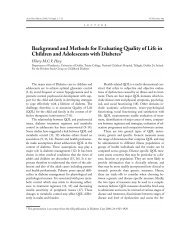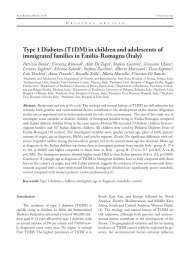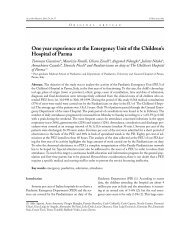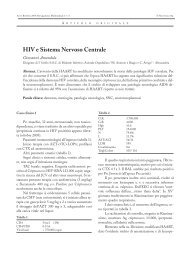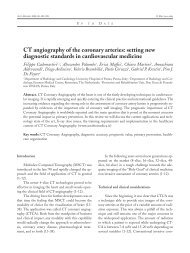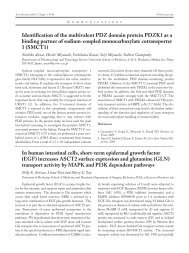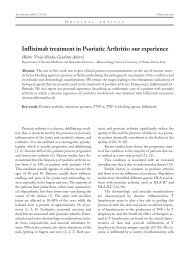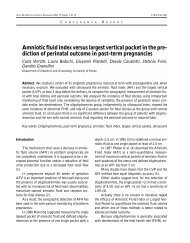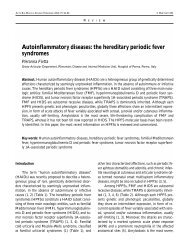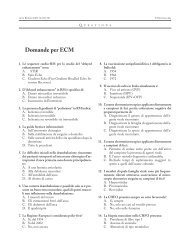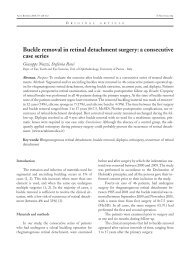View - Acta Bio Medica Atenei Parmensis
View - Acta Bio Medica Atenei Parmensis
View - Acta Bio Medica Atenei Parmensis
You also want an ePaper? Increase the reach of your titles
YUMPU automatically turns print PDFs into web optimized ePapers that Google loves.
8 P.G.F. Swift<br />
from the start, thus improving the prospects of preventing<br />
both short term crises and long term vascular<br />
complications.<br />
Preventing vascular complications<br />
In 1977 it was reported that strict glucose control<br />
was able to prevent diabetic retinopathy. But this was<br />
in dogs (10)! Such a statement had been the subject of<br />
debate and controversy in human (and particularly<br />
childhood) diabetes for many years. It was only in<br />
1982 that the Oslo study was initiated to try to answer<br />
this debate. Forty-five young people, diagnosed with<br />
type 1 diabetes between the ages of 10 and 29 years,<br />
were recruited. The average age of participants at the<br />
start of the Oslo study was 24 years, with duration of<br />
diabetes more than 7 years. They were divided into 3<br />
groups: conventional therapy, insulin pumps, and multiple<br />
injection therapy. It was worrying that initially<br />
with more intensive therapy the tightening of blood<br />
glucose control in this and other studies, was associated<br />
with a worsening of retinopathy (11-13). This<br />
phenomenon had been termed “the paradox of normoglycaemic<br />
re-entry” (14). Fortunately, in Oslo this<br />
was found to be transient. (15). The improvement in<br />
retinal microvascular complications with continued<br />
intensified insulin treatment was also noted in the<br />
KROC study in London (16) and in the Steno Copenhagen<br />
studies (17) and its aetiopathogenesis has<br />
been the subject of speculation and debate (18).<br />
In the Oslo study, after 4 years of improved control<br />
with near normoglycaemia and better glycated<br />
haemoglobin a delayed onset of microvascular complications<br />
was recorded. It was shown that both CSII<br />
and multiple injection therapy were superior to conventional<br />
therapy (19). Thereafter all patients were<br />
encouraged to use intensified insulin regimens and<br />
throughout the long term follow up of the study<br />
group, HbA 1 c values have been measured.<br />
A similar long-term intervention study in adults<br />
with diabetes of 17 years duration was set up in<br />
Stockholm in 1982. The group was divided into an intensive<br />
group seeing the same physician every two<br />
weeks for a period of time and taking at least 3 injections<br />
of insulin per day. At the 7.5 year follow up the<br />
differences between conventional therapy and intensive<br />
therapy showed HbA 1 c 8.5 vs 7.1 %, retinopathy 52<br />
vs 27%, nephropathy 17 vs 2% but slightly more hypoglycaemia<br />
in the intensive group (20). This further<br />
study confirmed once again that the lower HbA 1 c resulted<br />
in lower microvascular complications.<br />
The remarkable Oslo study has more recently focussed<br />
on macrovascular disease with further follow up<br />
after 18 years. Intracoronary ultrasound studies have<br />
shown silent coronary atheromatosis in 100% of the<br />
29 patients studied at an average age of 43 years, duration<br />
of diabetes 30 years and average HbA 1 c 8.8%.<br />
Thyrty-five% of the patients had 40% or more stenosis<br />
of one or more of the coronary arteries (21). It was<br />
noted that for every increment in :<br />
• HbA 1 c of 1% there was a 6% increase in coronary<br />
artery stenosis<br />
• serum cholesterol of 1 mmol/l there was a 10%<br />
increase in coronary artery stenosis<br />
• duration in diabetes of 10 years there was a 16%<br />
increase in coronary artery stenosis.<br />
At the time of the start of the Oslo study, 195<br />
adolescents were being recruited into the diabetes<br />
control and complications trial (DCCT Bethesda) in<br />
the N. America. They were aged 13 to 17 years at entry<br />
and were studied for an average of 7.4 years. The<br />
intensive therapy group received extraordinarily intensive<br />
management with either multiple injections or<br />
continuous insulin infusions, self-monitoring of blood<br />
glucose at least 4 times per day, strict goals and targets,<br />
at least weekly telephone contact with a diabetes professional,<br />
monthly visits to the clinic and monthly<br />
HbA 1 c measurements. The impressive results of this<br />
arm of the study were reported in 1994 (22), showing<br />
a clear separation between the intensive group achieving<br />
an average HbA 1 c 8.1% (1% higher than in the<br />
adult DCCT group) and the conventional group having<br />
an average HbA 1 c 9.8%.<br />
This group of adolescents showed that with the<br />
sustained decrease in HbA 1 c of around 2% there was a<br />
reduction in the risks of microvascular complications<br />
by 60 to 70%. This result was deemed to outweigh the<br />
adverse effects of a three-fold increase in severe hypoglycaemic<br />
events and a two-fold risk of becoming over<br />
weight. It was important to note that in the DCCT<br />
there was no threshold HbA 1 c below which complica-



